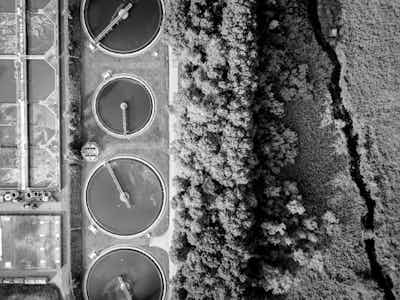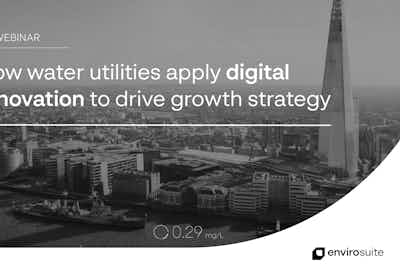On September 6, Envirosuite hosted with Smart Water Magazine a webinar with the title “How water utilities apply digital innovation to drive growth strategy”, exploring this topic and current best practice.
Watch the webinar recording
The webinar brought together water utility and technology vendor perspectives to offer a detailed conversation on digitalisation: what technologies are in the market, and how they can be applied to optimise service delivery and improve resilience.
The three panelists were Daniel Lambert, Executive Manager, Sustainable Infrastructure Solutions at Unitywater, bringing the unique perspective of a water utility that provides essential water supply and sewage treatment services in parts of Queensland; Chaim Kolominskas, Manager of EVS Water – Envirosuite’s suite of solutions focused on improving environmental and operational performance in the water industry, and Jide Fadero, EVS Water Lead for EMEA at Envirosuite.

What does the digital transformation mean for water utilities around the world?
When commenting on the role of the digital transformation, Daniel Lambert noted the importance of understanding the context: the core business of water utilities is to provide reliable and safe water and wastewater services to customers. Faced with challenges such as growing populations, climate change, etc. digital transformation is about using digital technology to respond and innovate better ways of delivering services, including improving services to customers as well as environmental benefits, and preventing issues.
"Digital transformation is about using digital technology to innovate better ways to improve customer services and environmental benefits, while preventing issues."
Daniel Lambert, Executive Manager, Sustainable Infrastructure Solutions at Unitywater
Chaim Kolominskas added, “While transformation has so far focussed on collecting, storing and displaying data, there is now an opportunity to use that information in a way that drives improvements in operational and environmental performance.
“I think Envirosuite’s business really started taking off after we began to understand what translating information into something useful really meant from a product design point of view: what information, in what form, in whose hands and with what frequency are really important factors when implementing a digital transformation.”
What are the risks of going digital and how can water utilities address them and benefit from implementing digital solutions?
Jide Fadero pointed out regulatory risks, such as the introduction of new regulations that utilities were not planning for or their strategies do not align with, forcing them to reassess their strategies in order to adapt.
“For example, some water utilities in the UK focused on the sewage network, which have to adapt to a new Environment Agency regulation that calls for the utility to understand the quality of the wastewater before it is released.”, he said.
“Other risks include the cost of digital technologies; after a successful pilot, deploying a technology fully across their assets may be quite expensive. To address this, water utilities can conduct digital technology reviews to ensure that the most relevant and most modern and cost-effective digital technologies are implemented. Data protection is another obvious risk.”
Water utilities can mitigate or remove these risks by conducting digital technology reviews to ensure that the most relevant and most modern and cost-effective digital technologies are implemented.
Dan outlined some of the risks from a utility perspective: not having a clear strategy, lack of collaboration between utilities and technology providers, and not investing in knowledge and appropriate capacity building. Also, challenges around costs and quality of data, with increased costs due to more data being stored and consumed. He also cautioned about the risk of investing in technology that becomes obsolete or requires significant investment, thus becoming a burden on the utility.

Is digitalisation directly connected with improved efficiency for water and wastewater utilities?
“There is evidence to support that, for instance in trials done with 10,000 digital meters on their assets, data shows efficiency improvements in things like non-revenue water.”, Dan shared and emphasised the need to make sure you have the right technology for the right purpose and context.
“While digitalisation enhances decision-making efficiency, it also enables predictive analytics, one of the things where there is currently a lot of investment in the industry, to focus efforts based on predictions of where breakages and bursts might occur.”
"You can see some significant savings in chemicals and labour in one small part of the process - and imagine that scaled up for the whole treatment plant."
Chaim Kolominskas, Manager of EVS Water at Envirosuite
Chaim shared examples from projects that Envirosuite is working on in Asia, where he saw the clear connection between efficiency and digitalisation. In one project, information already available at the plant, combined with near-real-time and predictive modelling, is used to work out exactly how much coagulant is needed at a drinking water facility, without the need to involve the laboratory at all, thereby saving in chemicals and labour; that can be scaled up to the whole treatment plant.
“In another example from a sewer network in Australia, using information that is routinely collected, complemented with some modelling, it is possible to map risks related to corrosion and build-up of methane and sulphides across the whole network and avoid any incidents, which can be costly and be extremely disruptive and dangerous, as well as reduce the amount of monitoring. Efficiency gains can be tied to the concept of digitalisation and seen across the whole industry,” he said.
While digitalisation enhances decision-making efficiency, it also enables predictive analytics, one of the things where there is currently a lot of investment in the industry.
Since digitalisation encompasses countless solutions, how can water utilities and operators know which technologies are best suited for their specific needs?
Dan noted the importance of understanding the current state of a utility, and what we would like the future state to be, to focus on the technologies and solutions that can help get there. In this regard, a clear strategy, plan and roadmap is really helpful to prioritise and identify the right types of technology applicable at the right stages of the journey.
Jide agreed, and added that those objectives and goals come from what the utility has internally planned for growth, but they should also align with what third party regulatory bodies have planned,
A clear strategy, plan and roadmap is really helpful to prioritise and identify the right types of technology applicable at the right stages of the journey.
for example, in the UK, the Environment Agency or Ofwat. This will help utilities plan, come up with
projects and subsequently, select the digital technologies to help achieve those goals and objectives.

What is the best way to apply new technologies to achieve the best outcomes?
Chaim noted that, in essence, applying new technology is about driving change through an organisation.
“The experience at Envirosuite shows a couple of factors come up repeatedly, one is having an internal champion committed to driving improvements within the water utility.
“At the same time, Envirosuite, as a vendor, puts a lot of time into understanding the needs of different stakeholders within water utilities, which are often large organisations. In our recent project in Western Australia where we implemented our pro-active odour management technology, we found it was crucial to spend time with different stakeholders – operations, planning, safety, environment, asset strategy – during the delivery of the technology, and listen to their feedback,” he shared.
Chaim also stressed that the example reflects Envirosuite’s approach - some of the best innovations that they have delivered to the market have come from listening, truly listening, to customers and translating that it into product design.
From a utility point of view, Dan advised being ambitious but realistic, and not to try to reinvent the wheel, as vendors can sometimes do things better than a utility can, or already have experience doing it.
Can you comment on the importance of having in-house digital capability when it comes to implementing new digital solutions and ensure the data generated can be turned into insights?
Jide emphasised the importance of in-house digital capability, as utilities know what the issues and their objectives are.
"When utilities talk to external vendors, collaboration can lead to unique and innovative solutions."
Jide Fadero, EVS Water Lead for EMEA at Envirosuite
“A way for a utility to stay relevant is to know what’s relevant in the digital landscape, and suggested they continually survey the digital terrain to know when new technologies that have added value are on the market. When utilities talk to external vendors, collaboration can lead to unique and innovative solutions,” Jide noted.
Dan added that regardless of their in-house digital capability, no utility has the skills to solve all the problems in the most efficient and effective way, so partnerships with vendors and collaborations are key. Going through co-development, co-design and co-delivery processes, it is possible to get the best expertise from the vendor and apply it in a bespoke way. He added that having the right governance is also important to maintain oversight.
Is it better for utilities to start small, or to embrace digitalization completely, when starting from scratch?
Chaim said while as a vendor they will be interested in utilities embracing digitalisation completely, they often start small to prove the value of their products. He pointed out that utilities will want to see that an optimisation solution can save money at one part of the treatment plant before expanding to the whole plant or deploying at multiple plants. He also remarked that digitalisation is happening everywhere and it’s important for organisations to have a plan for where to go, and how to get there.
Dan suggested it depends on the type of technology and the type of solutions. He stressed that, regardless of whether it’s a small- or large-scale rollout, it is key to always have a clear way of monitoring progress, measuring success, and having good governance and oversight, in order to ensure the success of projects.
A clear way of monitoring progress, measuring success, and having robust governance and oversight, in order to ensure the success of projects.
(Courtesy of Smart Water Magazine)
